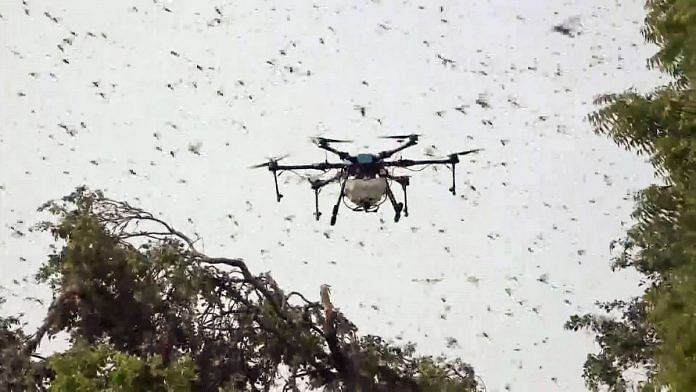New Delhi: The Ministry of Civil Aviation Thursday released a draft policy for drones, which brings in more safety features and appears to address some concerns in India’s nascent unmanned aerial vehicle (UAV) industry regarding the compliance norms outlined earlier.
When finalised, the draft policy, titled Drone Rules 2021, will replace the Unmanned Aircraft System (UAS) Rules 2021, which came into force in March this year. It is open for public suggestions until 5 August.
Built “on the premise of basis of trust, self-certification, and non-intrusive monitoring”, the draft policy reduces the number of approvals required by applicants. It brings down the number of forms to 6, from 25 under the UAS Rules, and reduces fees for certain approvals.
It makes a push for ‘Made in India’ technologies, includes exemptions for research and development (R&D) activities, and envisions a drone trade body.
Notably, it proposes mandatory safety features like ‘No permission – no take-off’ — also a part of UAS Rules — while also calling for drones to be equipped with a real-time tracking beacon and geo-fencing, a technology that will help trigger alerts when the vehicles cross a certain boundary, for example, when they come too close to an airport.
Drone owners who don’t have these installed will have to incorporate them within six months of the rules coming into effect, the draft policy states.
The new rules come over a month after India witnessed what has been described as the country’s first-ever terror attack carried out by a UAV. In June, drones released explosives over the Air Force station in Jammu, mildly injuring two personnel and bringing attention to a new kind of threat.
There have been other suspicious sightings of drones in the days since, and at least three districts in Kashmir have banned them in the aftermath.
The new drone rules also seek to ease the entry of foreign manufacturers into the market. Drone manufacture, trade, operations and ownership in India are currently limited to companies with majority Indian ownership and control, but the new policy seeks to lift this restriction. According to Amber Dubey, Joint Secretary, Ministry of Civil Aviation, opening up to foreign companies will help make India a “drone hub”.
“We want the best of the best drone companies to come to India and do joint research, development, manufacturing here,” he told ThePrint.
Also Read: 2 drones, 2 kinds of IEDs, separate strikes — How Jammu air force station attack was planned
Reducing burden of compliance measures
Drone Rules 2021 will apply to individuals owning, possessing, exporting, importing, manufacturing, trading, leasing, operating, transferring or maintaining a drone in India. They don’t apply to drones used by the armed forces.
A major highlight of the policy is the abolition of approvals like unique authorisation number, operator permit, and authorisation of R&D organisation, among others.
The new rules come at a time when the DigitalSky platform — an online management platform for drones set up by the government — has become fully operational. The website, under construction since 2018, was something those involved in the industry had been keenly awaiting.
Asked if the revision in the rules was a response to grievances about the UAS guidelines, Dubey said “rules have to evolve” with the “pace of change in drone technology”.
“Drone Rules 2021 are just a step in that direction. Drone rules in 2025 and 2030 could be completely different from this. The government works closely with the drone academia and industry. In their success is India’s success,” he added.
Welcoming the new policy, Lalit Gupta, president of AvTech Forum of India (ATFI), an industry body, told ThePrint: “The new draft rules of July 2021 are welcome primarily because they are built on a premise of trust, self-certification and non-intrusive monitoring. Numerous approvals have been abolished and the number of forms has been drastically reduced. It has also liberalised rules for R&D activities of drones. These will provide a significant boost to the industry.”
Push for ‘Made-in-India’ drone technology
The new rules mention a “Certificate of Airworthiness” to be obtained by manufacturers and importers, which will be mandatory for all drones weighing more than 250 g and less than 500 kg.
The certificate will be issued by the Quality Council of India or a certification body authorised by the government. If formed, these bodies will work to promote the use of ‘Made in India’ components and India’s regional navigation satellite system.
The draft policy also talks about a potential trade body called the Drone Promotion Council to develop “a business-friendly regulatory regime”. The council will work on automated permissions, incubator centres, and organise drone technology events and competitions, states the draft policy.
“The council will comprise representatives from academia and the industry. Many drone committees at MoCA (Ministry of Civil Aviation) already have external members,” Dubey said.
The rules also envision a drone corridor that, Dubey added, will cater to deliveries and taxis.
A drone taxi, or passenger drone, is a pilotless helicopter that can fly at a speed of around 130 km/hour.
Asked if the new rules will accommodate online delivery platforms like Zomato or Amazon, Dubey said: “Drone deliveries will be commonplace under the new rules. Drone corridors will be developed, especially in populated areas, so that safe operations can be ensured.”
This report has been updated to correctly reflect the name of the industry body AvTech Forum of India. It was earlier mentioned as Aviation Technology Forum of India.
(Edited by Sunanda Ranjan)
Also Read: Nano, micro, small: The different drone types in India & if Jammu-like strike can be averted



